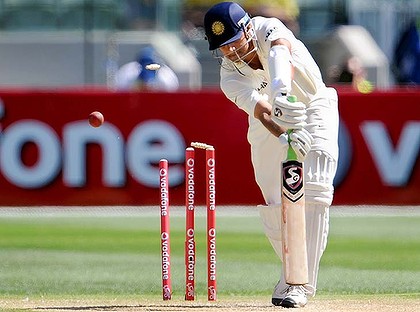Australia are reminding Indian fans of the disaster that happened in England not long ago. Plus, they are on the verge of inflicting the same result on India, i.e., a series whitewash come 24th January at the Adelaide Oval.

And the reason for their downfall is the same, a collective batting failure. If this series cannot bring about change in Indian cricket, then I don’t know what will? One bad series does not make a team bad, but two bad series is a big reason to worry about for the BCCI, which is rightly being criticized for being short-sighted in their selection policies.
Rahul Dravid, Sachin Tendulkar and VVS Laxman undoubtedly have formed one of the most powerful batting units in Test cricket over the last sixteen years. They were a part of the ‘Fab Four’ of Indian cricket, with Kumble being the fourth member. But now the trio in combination is no more effective and age is not helping the three of them. Dravid turned 39 six days ago, Tendulkar will also become 39 in April and Laxman is 37. The Indian batting maybe the most experienced in the contemporary era, but experience is not ‘everything’ in Test cricket. To make the team move forward, there has to be a well thought out exit plan for the seniors so that youngsters are given an excellently timed opportunity to begin their Test careers, with they being likely at their finest of nicks coming fresh from domestic cricket.
This is where successful sports teams have been wonderful at. They know when and how to bid farewell to the players who have served them so well over the years. Ironically, the best India can do is to take a leaf out of Australia’s book. Australia has always emphasized on the nation to come first before an individual. So for example, Ian Healy was convinced to resign gracefully in late 1999 when he was no longer considered efficient enough for being the wicketkeeper of the Test side, and that period also co-incided with the rise of Adam Gilchrist who had previously played three years of ODI cricket and met with much success. The reactions to the decision was mixed but turned out to be beneficial for Australian cricket as Gilchrist went on to serve the nation for nine years in Tests, being an integral part of a world champion side.
If not as much in cricket, even in football the same happened with Manchester United. The moment it was decided that the likes of Wayne Rooney and Cristiano Ronaldo had to be bought into the side, seniors such as Ruud van Nistelrooy and Ryan Giggs were benched for some of the matches. And all die-hard United fans would know what happened from there on, as Rooney and Ronaldo went on to form one of the finest goal-scoring pairs in the English Premier League for a span of five years while Nistelrooy was transferred soon after and Giggs continues to play till date, impressive even in a supporting role to the youngsters.
India will have to do something similar. Laxman is under the maximum pressure amongst all the batsmen in the side as he failed in England miserably and in Australia, which is one of the favorite countries to bat in, this time though scoring just one fifty in six innings. The manner of his dismissals are a clear indication that he is not the same ‘Very Very Special’ Laxman who hit a gritty 96 twelve months ago, to win India a historic Test at Durban. In the recent home series as well against the West Indies, his hundred in Kolkata was scratchy to a certain extent.
The most preferable option for the team management at present would be to drop Laxman from the Adelaide Test and let Rohit Sharma make his much-awaited Test debut even if Virat Kohli is asked to bat at No.5. India has nothing to lose after all and it would be better to lose four in four, with Rohit atleast being experimented with. Rohit has been in contention for a Test spot since mid-2011 and has been in the ODI team since the last four years. Ian Chappell in one of his write-ups sympathizes with him by saying that he is in grave danger for being one of the wasted talents of Indian cricket if he will not make his Test debut any time sooner since he is already 24. As of Laxman, he could handed a grand farewell by playing in the next Test series India will feature in, and it could be at home against New Zealand.
As of Rahul Dravid, there is a huge hole been created in ‘The Wall’. He has now been bowled 54 times in Tests, which is the highest ever in Test cricket by any batsman. His reflexes have certainly slowed down, and that explains why he has been unable to negotiate with quick pace and swing. There is nothing wrong with his technique as such but age seems to be finally catching up with him. However, to throw Dravid out of the team in the near future alongside Laxman would be naïve as it should be remembered that he was the highest run-getter in 2011 of all Test batsmen with centuries in West Indies and England, when the rest failed.
Dravid has the IPL to play after this tour, since he will not feature in ODIs in the next three months. The fantastic work ethic that he has, he will look to gain as much as possible from the experience in terms of practice and honing his skills. He could be given the ultimatum for the home series against England in the end of this year or if even he does well, he must be asked to retire or retire on his own after the series as a player should finish his career on a high and what better than in an Indian ground!
His replacement could be the likes of Cheteshwar Pujara or Ajinkya Rahane, who is there in the squad for this tour. Pujara had played 3 Tests for India in 2010 and against Australia on his debut in Bangalore, he batted at No.3 in the second innings above Dravid, and hit an unbeaten 72 to steer India home by 7 wickets. He also featured in 2 Tests in South Africa but failed there. Yet, he will turn 24 soon and with his experience in the IPL and performances in domestic cricket growing, he is one of the men to watch out for.
Sachin Tendulkar has by far been the best batsman in the Test series for India so far. Although he has also been subject to criticism for not scoring his much-anticipated 100th ton in this series, it is only a matter of time that he will reach there as Tendulkar shows no signs of poor form. He has not been a part of the one-day series for nine months now, and that is perhaps to increase his longevity in the Test side. But Tendulkar cannot play forever, can he? He is close to being 39, and has achieved what any batsman cannot even dream of, in international cricket. His long-standing goal of being a part of India’s World Cup winning the side was fulfilled in 2011.
So what exactly is making Tendulkar continue playing for India? It could be the fact that it is impossible for any batsman in domestic cricket to fill his shoes, despite the Ranji Trophy witnessing some stellar batting performances. He is definitely evergreen, but he will have to quit someday and for the sake of his country, he should in the short run. He can carry on for another eighteen months at the most, so that he can give the Indian selectors more time to search for the bright talented lad who can be competitive enough to play Test cricket. Besides, Tendulkar can also act as a mentor-cum-player for the Test side by lending a helping hand in fine-tuning the skills of the young and inexperienced batters just as Ricky Ponting is doing for Australia at the moment. Admittedly, India needs atleast one wise head in the side and who better than the Little Master?
But even as the middle-order is under the pump, the meager contributions of the openers in this series cannot be sidelined. Virender Sehwag and Gautam Gambhir, the Delhi duo could be rated as one of the finest opening pairs in Indian cricket, but their failures in the last twelve months have been alarming whether it is in terms of partnerships or individual contributions.
Barring the home series against West Indies, Sehwag and Gambhir have not been able to put up big partnerships in Tests outside the Indian subcontinent in particular. Sehwag had a poor 2011 with 382 runs in 11 innings featuring no century. Come Australia and its worse times for him, hitting just 118 runs in 6 innings. However, obviously he is a prolific run getter in the Indian subcontinent and with no series outside it for the next two years, Sehwag is likely to hit back as quickly as possible. He has over 8000 runs in this format, and still has 3-4 years of cricket left in him. So, it is unlikely that any action will be taken against him but his contributions in this series have hurt the team big time, which wanted him to give them attacking starts.
Gambhir’s form though is under much more scrutiny. It has been close to three years now, since he last scored a Test century (against Bangladesh at Chittagong in 2009), with his average being below 30. He has had a spat of injuries which has made it tough going for him in Tests, but when he had to step up to the occasion, i.e., playing Australia in Australia, he could not. Although he scored a decent 83 at the SCG in the second innings, his frailties to a good length ball outside off stump, especially with a hint of swing in it, have been exposed to a huge extent and he has made the mistake of poking at such deliveries over and over again. These are worrying signs for Gambhir, as oppositions do come to know about this with technology playing the culprit.
The question is whether Gambhir should be dropped or not following a poor 2011. He should not, since he is a classy player, especially when it comes to playing spin and he could regain his form this year. But if his woes continue, then he should be. Having said that, who is capable enough of replacing him? Ajinkya Rahane is a better option for India as an opener than a middle-order batsman, as he has opened for Mumbai in domestic cricket in his entire career. He had shown shades of his talent in the ODIs in England last year, but Test cricket is a different ball game altogether and it remains to be seen whether he deserves to play at the international level or not.
Apart from Rahane, there is Murali Vijay in contention as always, primarily due to the chairman of selectors being from the South. Vijay recently hit a hundred in the semifinal against Mumbai, in what has been an astonishing 2011-12 Ranji Trophy campaign for him and his team Tamil Nadu so far. For India, he has appeared in a couple of Test matches before, as a replacement for Gambhir or Sehwag usually. But his problems with the short-pitched delivery is popular enough, although he too alongside Rahane has the temperament to play Test cricket.
But putting aside these two, there are no ‘young’ batsmen as such in the domestic circuit currently who are capable of being bought in to play Test cricket for India in the next 18 months or so. Even if the IPL is a talent hunt for the Indian selectors, it is not the only criterion to judge a player’s capabilities. This is the acid test for the BCCI, which needs to bring about an overhaul in domestic cricket to ensure that there are top quality batters or players for that matter to arise out of it on a frequent basis.
Possibly, state associations could be ordered to prepare pitches which are more of green-tops or are hard, but have a great amount of bounce in it. This will test the batsman in his developing years as a cricketer, and it is rightly said ‘Charity begins at home’. It can make him adjust to any pitch or conditions in the world, making him a wholesome batsman much like Sachin Tendulkar. And who knows, India could go on to win series overseas and not just matches in the future, just like in the Sourav Ganguly era.
Even when it comes to bowling, Indian bowlers will be helped greatly by such pitches and although the bowlers have outshone the batters in Australia, the overall bowling performance was mediocre with India picking only 1 wicket for 836 runs, between the first innings of the SCG Test and the Perth Test. Zaheer Khan is not the fittest bloke around and he has a maximum of 2-3 years of cricket left him. The bowling resources look deplete, as there are the likes of S Sreesanth and Varun Aaron who are contenders to fill the fast bowling department in the Test side. Ishant Sharma is still impressive but was a tad unfortunate on this tour, while Umesh Yadav has won the hearts of many with his performances, considering this being his first trip overseas.
Then comes Dhoni’s captaincy, which is a huge concern for India if they have to win Tests abroad on a regular basis to actually become champions in this format of the game again. He tends to be too passive and defensive at times, but this style has been prevalent often on this tour in particular. It was shocking to see Dhoni put 3-4 fielders in the deep with James Pattinson being the new man at the crease in the second innings of the MCG Test. Michael Hussey was at the other end, but India had the upper hand as Australia were eight wickets down and had a lead of slightly over 200 runs. Pattinson ended with an unbeaten 37 and India were to chase 292 to win the game, which they failed to eventually.
Dhoni might be restrained and calm in his approach, but with teams such as England in England and especially Australia in Australia, he needs to be more proactive and aggressive. He perhaps does not possess the charisma of a Ganguly to fire up his team in the most pathetic of situations. No wonder then that he says ‘I am the main culprit’ in a press conference, when he explained about India losing three in a row in the series.
Besides, his batting as well has not been upto the mark. A captain has to lead from the front when his team is in trouble. Dhoni just does not have the technique to succeed in the long-term in Test cricket. All these factors combined have seen India lose 7 consecutive Tests away from home under his stewardship. He has been affected tremendously by these failures. So much so, that he declared on the eve of the Perth Test that he could give up a format of the game, which is likely to be Test cricket by 2013 as a prerequisite to star in India’s World Cup defence in 2015. If he does go on to quit Tests, it shows his lack of interest in the format of the game and these are not ominous signs for an Indian team in tatters due to an aging batting line-up and scarce bowling options to choose from.
Surprisingly, the IPL is also blamed by many for India’s non-performance Down Under. I do not buy this argument as the tournament has got nothing to do with the Indian batsmen not succeeding in Australia. Dravid, Tendulkar and Laxman are the same Test cricketers as they have been always and things have not gone right for them this time around. Sehwag continues to play his natural game in Tests, but this time it has backfired. Gambhir has been woefully out of form in Tests for a long period of time and this series was a mere extension of it. Kohli’s inexperience did not let him have a memorable tour while Dhoni cannot adapt to the rigours of batting for as many balls as possible in Test cricket.
However, the IPL does add to an already hectic cricketing calendar for India and most players are in the national reckoning more due to this tournament than the Ranji Trophy. So the BCCI has to focus on balancing their selection of players with respect to both the competitions, while trying to reduce the number of international matches India play in a year. If not, they must continue to rotate players even in Test matches and not just ODIs, so that India contains a huge pool of 20-25 players who can make it to the national side any day and thus the nation can start winning Test matches and series away from home all over again.
But India is unlikely to embrace change, courtesy the BCCI. It is believed that good teams are a by-product of a good administration. Unfortunately though, the BCCI has no attributes to call itself even an ‘average’ administration, with its sole focus being, to make profits time and again and in whichever way possible. The Board members are often selected on the basis of their influence and not their cricketing IQ, so it is no surprise that it has politicians such as Rajiv Shukla or businessmen such as N Srinivasan, who is also the President of the BCCI who have no clue as to how to run a ‘cricket’ board.
Srinivasan, when asked about India’s debacle in Australia, had a bizarre defence for the side. He believes that Australia made full use of their home conditions. But when England and Australia come to India in the coming months, India will win since both the teams according to him, cannot beat India at home. And with that everyone will be happy again.
Sorry Mr. Srinivasan, but this is seriously not acceptable from a person of your stature. Champions in sport, make merry and win in all conditions and countries and not just at home. India may become the World No.1 team again in the ICC rankings, but will they be worthy enough to be called No.1? Fans cannot continue to grieve like this, as India has been humiliated in England and Australia in a span of 6 months. Besides, ignoring a problem does not help in solving it and that is perhaps what the BCCI will do after Srinivasan’s comments.
So I do not see any drastic changes likely to occur in the Indian set up in the short-run, even though the administration might consider Dhoni’s opinion of ‘gradually’ phasing out seniors. Certainly, it is ego which has brought Indian cricket on its hunches as of now.






Leave a Reply